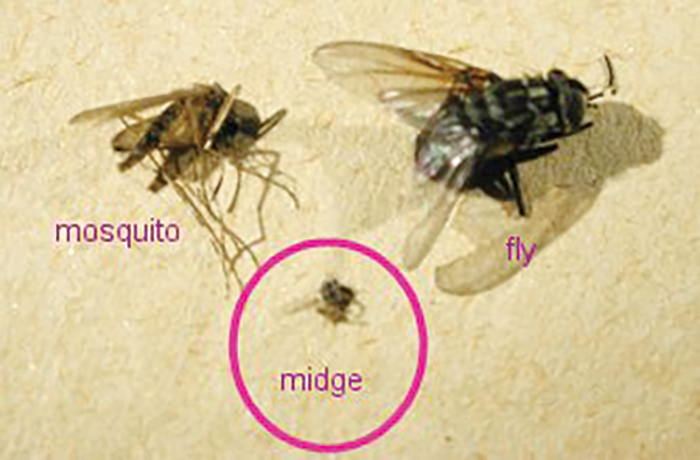By Pam Teel
Ceratopogonidae is a family of flies commonly known as no-see-ums, or biting midges, with adults being only 1/8 inch in length. The family includes more than 5,000 species, distributed worldwide. There are 47 species of no- see-ums in Florida alone, seven of which like the humans a lot!
It’s bad enough we have the jersey mosquito, but these little invaders enjoy our blood just as much and we don’t even know what’s hitting us. No buzzing noise, nothing. We go to the mailbox to get the mail and come back with itchy bites all over us. As the nickname, no-see-um implies, they might be difficult to see with the naked eye, and it’s the female you have to look out for. Females need a blood meal, ours, to produce eggs.
These insects are gray, and their wings are covered with small hairs producing patterns that allow entomologists to identify different species. Larvae may resemble small, whitish worms or caterpillars. Both male and female no-see-ums feed on plant nectar. No-see-ums go through complete metamorphosis with four stages. Eggs hatch within two to seven days after being laid. After hatching, flies go through four instars during the larval stage which can last from two weeks to one year, depending on environmental conditions, species of fly, and region. This is followed by the pupal stage (two to three days) and adulthood. The typical lifespan of an adult no- see-um is two to seven weeks.
The bite of a no-see-um can cause a burning sensation accompanied by a small red welt. Allergic reactions, including itching, may also occur. Because of their small size, many people would be unaware they were being bitten by a no-see-um if not for the associated irritation. They usually bite during the hours of dusk and dawn and rarely bite during daytime hours. Females primarily blood feed on mammals, but they may also blood feed on other animals such as birds, amphibians and reptiles.
While they are a nuisance, no-see-ums are not known to spread pathogens causing human disease in the United States. They can, however, infect other animals (horses, cattle and deer) with viruses that cause diseases like blue tongue and epizootic hemorrhagic disease. In affected countries, these diseases can cause millions of dollars in annual livestock production losses.
No-see-ums are usually a pest of campers, gardeners, fishermen, hunters, hikers, and others who spend time outdoors, especially near water. Immature stages of these insects are aquatic or semi-aquatic and lay their eggs in moist substrates in swamps, salt marshes, and agricultural areas with moist soil high in organic content, such as manure. Habitat preference depends on the species of no-see-um. I am of the mind that they breed anywhere, apart from the Artic and Antarctic.
Controlling no-see-ums can be difficult due to the widespread areas where eggs can be laid in moist substrates. Homeowners can take steps to prevent exposure to biting midges on their property, including installing screens (mesh must be smaller than 16-mesh insect wire) on porches and windows. No-see-ums are generally weak fliers, so ceiling and other types of fans can also help keep them away from areas where humans congregate.
To prevent bites from no-see-ums, avoid being outside during the hours of dawn and dusk. Campers should consider using tents equipped with “biting midge screening.”
Other than moving to the Arctic, the best alternative would be to spray yourself before you go out with an insect repellent that especially targets these invisible bloodsuckers. So, don’t be quick blame the jersey mosquito for the constant nights of scratching those itchy bites. No-see-ums pack a powerful punch on their own!

